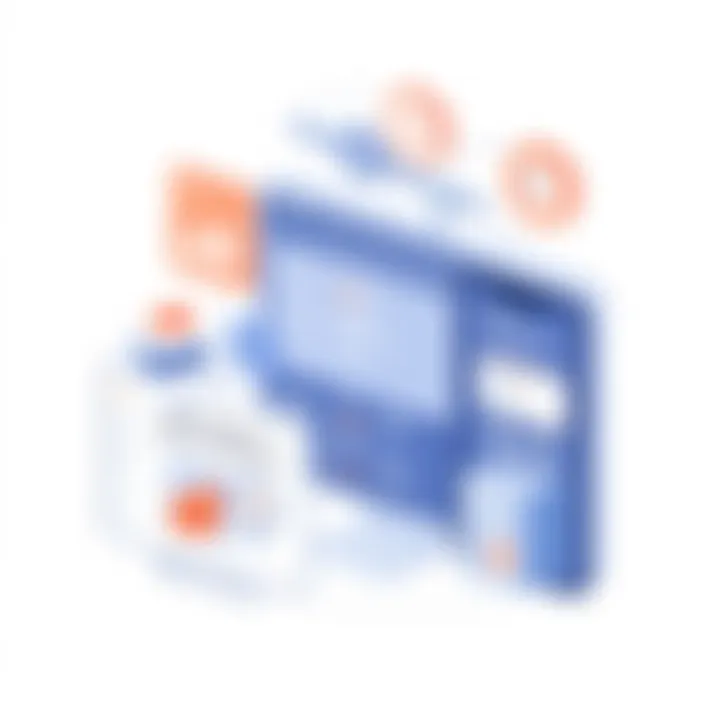Comprehensive Guide to Optimizely Full Stack Pricing


App Overview
Optimizely Full Stack is a powerful experimentation platform designed for developers and organizations looking to optimize their digital products through data-driven insights. Unlike traditional A/B testing services, this tool is tailored for devs who want to run experiments on their applications without being bogged down by the constraints of UI-focused testing. This flexibility is a game changer, offering deep integration into full-stack environments.
Foreword to the app and its main features
At its core, Optimizely Full Stack allows users to create robust experiments in various environments, from web applications to mobile apps and even server-side applications. Some standout features include intuitive SDK support, strong APIs, customizable targeting, and real-time data analytics that allow teams to make informed decisions swiftly.
Key functionalities and benefits of the app
The benefits of using Optimizely Full Stack are manifold:
- Robust Experimentation: Run complex experiments across multiple platforms with ease.
- Customizable Targeting: Drill down to specific user segments for precise insights.
- Real-time Results: Access to real-time data lets teams react quickly to findings.
- Collaboration Tools: Features that enable seamless collaboration among teams make it easier to streamline development and experimentation processes.
Understanding these core functionalities can drastically improve the way developers think about user engagement and product iteration.
Step-by-Step Walkthrough
Using Optimizely Full Stack may seem daunting at first, but getting started is quite straightforward.
- Setting up Your Account: Create an account on the Optimizely website, providing the necessary details.
- Integrating the SDK: Download and integrate the appropriate SDK for your tech stack. This could be for JavaScript, iOS, or Android, among others.
- Creating Experiments: Use the dashboard to create your first experiment. This involves selecting variables and defining your goals.
- Running the Experiment: Once your experiment is set up and activated, you can monitor its performance.
- Analyzing Results: After the experiment’s duration, analyze the results to see how variations performed against the control group.
Tips and Tricks
To squeeze the most out of Optimizely Full Stack, keep these tips in mind:
- Leverage Multi-armed Bandit Strategies: Don’t just run A/B tests. Use multi-armed bandit approaches for more dynamic optimization.
- Utilize Audiences: Take advantage of defined user segments to tailor experiments.
- Monitor Experiment Performance Closely: Regularly check on experiments to react to any unforeseen issues that might skew results.
Common Issues and Troubleshooting
Despite its robust framework, users might encounter a few hiccups:
- Slow Implementation: Sometimes integration takes longer due to unforeseen tech stack complexities. Ensure your environment is conducive to the SDK integration.
- Data Overload: Real-time analytics can lead to information overwhelm. Stick to key metrics that align with your primary goals to avoid confusion.
To resolve these issues, identifying and isolating problems early on is crucial. Teamwork and communication also help in troubleshooting effectively.
App Comparison
When comparing Optimizely Full Stack with other experimentation platforms, it’s essential to highlight what makes it unique.
- Full-stack Integration: Unlike simpler platforms that focus only on web views, Optimizely serves both front-end and back-end needs seamlessly.
- Enhanced Customization: Other tools may provide basic testing features, but Optimizely’s extensive customization opens the doors to deeper experimentation.
In summary, when navigating the ever-evolving landscape of digital optimization, understanding Optimizely Full Stack's pricing and functionality is vital. It’s not merely about the cost but the value it delivers to create meaningful user engagement and drive growth.
"Pricing is not just a number; it's part of an ecosystem that defines the value you derive from a product."
For further details, you might find these resources useful:
Prologue to Optimizely Full Stack Pricing
In the fast-paced world of app development, decisions regarding experimentation and analytics can heavily influence the overall success of a project. Optimizely Full Stack Pricing stands at the intersection of innovation and strategic financial planning. This article serves to explore the various facets of pricing associated with this platform, enabling developers, tech-savvy users, and even those just dipping their toes into the world of apps to grasp how costs can impact their decisions.
Overview of Optimizely
Optimizely is a significant player in the realm of experimentation. Initially known for its web experimentation features, it has evolved and now supports a broader scope, facilitating real-time A/B testing, multivariate testing, and personalization across different platforms. The Full Stack version extends these capabilities beyond just the front end, allowing developers to integrate experimentation directly within their application backends.
With Optimizely, users can enhance user experiences and harness valuable data to guide design and functionality. The flexibility it offers encapsulates everything from feature flagging to structured experimentation. Given that it supports individual developers and large enterprises alike, understanding the pricing model is crucial to maximizing the return on investment.
Significance of Full Stack Experimentation
Full stack experimentation introduces a dynamic layer to the development process. Traditionally, testing happened mostly on user interfaces, but by going full stack, developers can make informed choices based on backend performance metrics. This shift allows for testing of more nuanced aspects of applications. It taps into how changes in logic can affect the overall user experience, which is pivotal in ensuring that every decision is performance-driven.


Adopting this method makes it relatively easier to implement changes across various environments, including staging and production. Programmers have the opportunity to test hypotheses in a controlled manner, alter variables, and measure outcomes effectively. This not only speeds up discovery but also enrichens the data collected during testing.
"Understanding pricing structures associated with full stack experimentation is integral for stakeholders considering Optimizely’s services and whether they align with organizational goals."
Thus, considering Optimizely Full Stack Pricing is not merely a financial exercise; it’s a strategic endeavor that helps shape the roadmap to a successful application, enabling developers to make tactical decisions enriched with empirical data.
Understanding Pricing Models
In the evolving landscape of application development, grasping the intricacies of pricing models is pivotal. For developers and organizations considering Optimizely Full Stack, understanding these models is not just about numbers; it’s about making an informed decision that can significantly impact both budget and project outcomes. Pricing models underpin how costs are structured, allowing users to weigh their options based on their specific needs and usage patterns.
When considering the right model, it’s essential to reflect on the scale of your project, anticipated usage, and required features. Each pricing model comes with distinct advantages and challenges, tailoring solutions to different user profiles. A clearer understanding aids in budgeting effectively, optimizing resource allocation, and ultimately achieving greater value from the investment in Optimizely. The following sections will dissect these models further to provide clarity and guidance.
Subscription-Based Pricing
Subscription-based pricing is akin to a regular membership payment, providing organizations ongoing access to Optimizely Full Stack features over a predetermined period, often monthly or annually. This model typically works well for companies with stable project requirements and steady usage patterns.
One of the benefits of this arrangement is predictability. Organizations can forecast their budgets with greater accuracy, aligning expenses with cash flow. For example, suppose a tech startup anticipates a consistent user base for app testing. In that case, a fixed monthly fee allows them to plan their budgeting with a degree of ease.
However, it’s not all rosy. Companies that fluctuate in usage might find themselves overpaying for unused capacity during slow periods. Still, for those with a regular push for experimentation, the reliability of this pricing model allows teams to focus on their tests instead of financial uncertainties.
Usage-Based Pricing
Contrasting with the fixed nature of subscription fees, usage-based pricing charges organizations based on how much they utilize the service. Picture it like paying per mile when renting a car, where the more you drive, the more you pay. This model is particularly appealing for projects that may have sporadic demands or varying scales of experimentation.
This flexibility can be a double-edged sword. It accommodates smaller teams who might not engage in rigorous testing during all phases of development, allowing them to avoid hefty monthly fees when demand is low.
Nevertheless, the inherent risk lies in the unpredictability of costs. For instance, if a campaign suddenly takes off and requires extensive testing, costs can balloon unexpectedly. Thorough estimation and careful monitoring come in handy to prevent budget overruns. Within this pricing strategy, maintaining an equilibrium between experimentation and expense is key to harnessing its full potential.
Enterprise Solutions and Custom Pricing
For organizations operating on a larger scale, or those with specialized needs, enterprise solutions often present a tailor-made opportunity. Here, pricing is typically negotiated based on the unique requirements of the organization, encompassing aspects such as the size of the team, the number of tests run, and required support services.
Custom pricing models facilitate a more collaborative approach, where companies can express their specific needs and budget constraints. For example, a large healthcare organization needing stringent data privacy and extensive compliance measures may negotiate a solution that aligns perfectly with their operational framework. This bespoke nature often entails close engagement with the provider, resulting in a closer partnership.
However, complexities can creep in. Negotiating terms can take time, and without diligent understanding of the specific offerings, companies can find themselves committing to deals that may not offer the expected value. Therefore, organizations must approach these discussions armed with clear objectives and a solid sense of their needs.
"Understanding the pricing models is as essential as the technology itself when budgeting for Optimizely Full Stack. Knowing what you’re getting into can save you a heap of trouble down the road."
In summary, the landscape of pricing for Optimizely Full Stack is layered and multifaceted. Exploring the nuanced details of subscription-based, usage-based, and custom pricing empowers app developers and decision-makers to navigate the offerings more strategically, ensuring that investments translate into tangible benefits.
Evaluating Costs and Benefits
In the rapidly evolving landscape of digital experimentation, evaluating the costs and benefits associated with tools such as Optimizely Full Stack becomes paramount. Understanding these facets not only aids businesses in determining whether the platform aligns with their financial parameters, but also unlocks insights into the potential returns and operational efficiencies that can be gleaned from utilizing it. For developers looking to fine-tune their experimentation strategies, comprehending the whole picture can significantly influence decision-making processes going forward. The following sections delve into specific cost elements and the promise of returns that comes with adopting this innovative platform.
Direct Costs Involved
When diving into Optimizely Full Stack, the direct costs are usually the first to surface. These encompass the obvious fees tied to subscription plans, which vary based on multiple factors. Here’s a breakdown of what you might expect:
- Subscription Fees: This is often tiered based on access to features. A basic plan may offer core functionalities, while higher tiers unlock advanced options, catering to different company sizes.
- Implementation Costs: Depending on your in-house capabilities, you might need to factor in the costs related to deploying the software. For some, this means hiring external consultants or developers who can implement and customize the solution effectively.
- Training and Onboarding Expenses: While the user interface is designed to be intuitive, there’s a learning curve. Invest in training sessions or resources to equip your team, ensuring they are set up to utilize the platform fully.
Indirect Costs Consideration
Indirect costs might not be as transparent as direct ones, yet they hold substantial weight in the overall financial picture. These costs can catch businesses off-guard if they are unprepared. Important aspects to contemplate include:
- Opportunity Costs: Engaging with a new software platform means reallocating resources, time, and focus from other projects. This could delay product launches or other initiatives that might yield revenue.
- Maintenance and Upkeep: Frequent updates and possible ongoing technical support can incur costs. If you lack a skilled team, you may have to rely on external support, which can be more expensive over time.
- User Adoption Challenges: If users are not adequately onboarded, the tool’s potential might not be realized, leading to reduced productivity. This hindrance can significantly affect the overall return on investment.
Potential ROI from Full Stack Experimentation
The crux of evaluating costs is understanding what you stand to gain from your investment. The idea of return on investment (ROI) transcends mere financial metrics; it encompasses the value added to your experimentation processes. Here are points to consider:
- Faster Experimentation Cycles: Full Stack allows for rapid deployment of tests across multiple platforms. Shortening the development cycle can lead to quicker insights and adjustments, ultimately improving time-to-market for new features.
- Data-Driven Decision Making: With a robust experimental platform, organizations can rely on real data to inform their strategies, rather than intuition. This shift can lead to smarter marketing campaigns and product adjustments that resonate more with users.
- Scalability: Investing in a platform like Optimizely Full Stack means positioning your company for future growth. As your user base expands, the ability to run extensive, targeted experiments can provide a significant competitive edge.
The transition to a data-centric approach is more than a trend; it’s a shift in how businesses view their interaction with users.


Navigating through costs and benefits is essential when contemplating the use of Optimizely Full Stack. By keeping a keen perspective on both direct and indirect expenses alongside the potential returns, businesses can craft a more informed strategy that ultimately drives growth and efficiency.
Factors Influencing Pricing
When it comes to understanding the pricing of Optimizely Full Stack, several factors play a crucial role in shaping the final costs. Knowing these aspects not only helps in budgeting but also assists in making informed decisions about whether this platform aligns with your organizational goals. In this section, we will explore key elements like scale of implementation, feature set requirements, and support and customer service levels that contribute to the overall pricing strategy.
Scale of Implementation
The scale of implementation refers to the breadth and depth of how Optimizely Full Stack is integrated within an organization. If you're rolling it out across multiple teams or divisions, the prices will likely vary compared to a focused implementation in a single department. The larger the scope, the more resources needed, which naturally impacts the bottom line.
- Enterprise versus SMB: Larger organizations usually necessitate advanced features and higher service levels, which might demand a premium. Conversely, small and medium enterprises (SMBs) could find sturdy, cost-effective options that meet their needs without bells and whistles.
- User Base: The number of users who will actively engage with the tool can also affect the pricing. A higher user count often leads to increased licensing fees, which can add up quickly.
"Choosing to implement at scale can be like opening Pandora's box; while it can lead to wonderful insights, it can also incur unexpected costs."
Feature Set Requirements
Every organization has its unique needs, and the feature set requirements can dramatically influence the cost of using Optimizely. If your team requires advanced functionalities such as A/B testing, multivariate testing, or personalization capabilities, you might encounter steeper fees compared to using just essential features.
- For instance, small businesses may only need basic experimentation tools. In contrast, enterprises aiming for complex analytics will require a richer suite that naturally affects pricing.
- Understanding which specific features you need can streamline decision-making and possibly lead to negotiating better terms if you can confirm minimal required capabilities.
Support and Customer Service Levels
Another pivotal factor that impacts pricing is the level of support and customer service you opt for. Different organizations have varied needs when it comes to guidance and support:
- Basic vs. Premium Support: Basic support may come included in your subscription, but if your team craves dedicated assistance, premium support packages come into play, often at a higher tier.
- Training and Onboarding: If you're a newcomer to the Optimizely ecosystem, you might want to invest in comprehensive training sessions. While this can raise initial costs, it could pay dividends down the line, enhancing your team's proficiency and maximizing tool usage.
Ultimately, all these factors blend together to craft a pricing structure that reflects your organization's operational dynamics. Evaluating them carefully will provide clarity and help you get the most bang for your buck while utilizing Optimizely Full Stack.
Comparative Analysis with Competitors
When diving into the waters of Optimizely Full Stack pricing, it’s essential to understand how it stacks up against the competition. A comparative analysis not only highlights the strengths and weaknesses of Optimizely but can also frame your understanding of how various offerings align with the unique needs of your team or organization. By carefully dissecting competitor offerings, users can make informed decisions regarding their investment.
Competitor Offering Overview
In the realm of experimentation platforms, several key players provide services akin to those of Optimizely. Familiar names on the roster include Adobe Target and Google Optimize. These platforms each have their distinct flavor of features and approaches:
- Adobe Target: Known for its integration with the Adobe Experience Cloud, this platform presents a robust suite for personalizing content across web and mobile. The focus tends to be on customer segmentation and deep analytical insights.
- Google Optimize: Offering a cost-effective option, Google Optimize appeals more to smaller businesses or teams starting their experimentation journey. Its integration with Google Analytics is a significant plus, allowing teams to pull actionable insights directly related to their testing efforts.
- VWO (Visual Website Optimizer): Focused more on the visual aspect of A/B testing, VWO provides a user-friendly interface that’s ideal for beginners. It combines experimentation tools with heatmaps and insightful analytics, bridging the gap between design and data.
These offerings show varying degrees of sophistication and attractiveness based on scale, complexity, and budget.
Pricing Strategies of Alternatives
Examining how competitors set their pricing strategies reveals the landscape’s dynamics. Most platforms employ a tiered pricing model, largely dependent on the volume of traffic and advanced features:
- Subscription-Based Pricing: Adobe Target typically uses subscription-based pricing with higher costs reflecting premium features. This could be worth the investment for large enterprises looking for extensive customization and integration capabilities.
- Freemium Models: Google Optimize presents a freemium model, allowing users to start with essential features cost-free. It’s a gamble that can pay off for those who want to dip their toes before possibly upgrading to more comprehensive features.
- Custom Solutions: Vendors like VWO often sell tailored solutions, negotiating pricing based on users' specific requirements, which can be beneficial for unique business models.
In light of these approaches, evaluating one’s priority—be it budget constraints or depth of features—requires careful consideration of these pricing methodologies.
Strengths and Weaknesses Comparison
In assessing Optimizely alongside its competitors, understanding the strengths and weaknesses can clarify the best choice for the user’s context. Here’s a brief synopsis:
- Optimizely Strengths:
- Optimizely Weaknesses:
- Competitor Strengths:
- Competitor Weaknesses:
- Comprehensive feature set for experimentation and personalization.
- Strong focus on performance metrics and analytics, allowing teams to derive actionable insights quickly.
- Excellent customer support, beneficial for teams lacking extensive experience in experimentation.
- Higher price point compared to entry-level competitors like Google Optimize.
- Steeper learning curve for new users due to advanced features.
- Adobe Target's rich ecosystem when fully integrated with the Adobe suite can provide extensive value.
- Google Optimize’s free tier makes it accessible for small teams looking to start learning without financial commitment.
- VWO, although user-friendly, may lack some advanced analytical capabilities inherent to Optimizely.
- Adobe Target’s higher price may repel budget-conscious startups or mid-sized businesses.
By juxtaposing these elements, users can gauge not just the price but the overall value each platform brings to the table. This aspect of comparing benefits and downsides is crucial in making a savvy choice that fits your business goals.


How to Optimize Your Investment
Navigating the world of Optimizely Full Stack can feel like traversing a winding road without a map. Understanding how to optimize your investment is crucial. It's not just about the initial costs but also understanding how to make the most out of the platform to see tangible results. Adopting effective strategies can lead to better long-term savings while maximizing your returns. Organizations, app developers, and tech-savvy users should be keenly aware of elements that can help enhance the value of their collaboration with Optimizely.
Implementing Cost-Effective Strategies
When it comes to managing expenditures, implementing cost-effective strategies is the name of the game. Consider the following tactics:
- Prioritize essential features: Before diving headfirst into the extensive capabilities of Optimizely, list down which features align with your objectives. Avoid unnecessary spends on features that won't serve your needs.
- Gradual scaling: Instead of going all-in from the start, consider phasing your implementation. This way, you can gauge the effectiveness of specific features before committing to comprehensive packages.
- In-house expertise: Training your existing team can reduce reliance on external consultants. Building an internal knowledge base can lead to more informed decision-making and less overall expenditure.
Adopting such strategies not only ensures better resource utilization but also gives a clearer view of how each invested dollar pays off.
Leveraging Free Trials and Demos
Optimizely usually provides opportunities to test out their platform through free trials and demos. Make good use of these options. Here’s why:
- Hands-on experience: Free trials allow users to interact with the platform firsthand, giving a real feel of its capabilities. Through demos, you also get to see potential use cases tailored for your industry.
- Discovery of functionalities: You might stumble upon features you didn't know you needed or that could simplify your workflow. This might just save you from diving into features that overcomplicate rather than streamline your processes.
- Assessment of support quality: During these trials, pay attention to how responsive the customer service is. It’s essential to know what kind of support you'll receive when you're an actual paying customer.
Taking advantage of these trials means you're not only exploring the product but also understanding your needs better.
Seeking Partnerships for Cost Management
Collaborating with other businesses can reduce individual costs significantly. Here's how to leverage partnerships to your financial benefit:
- Joint ventures: If you’re a smaller developer, teaming up with another company can help with costs like subscription fees. By pooling resources, you can afford a larger package that may offer additional features.
- Shared knowledge and resources: Partners can share insights and best practices to optimize techniques within the platform, enriching your experience without incurring extra costs.
- Bulk deals: Some companies may offer discounts for multi-user or multi-project access. Negotiating these deals can lead to significant savings.
User Experiences and Case Studies
User experiences and case studies serve as invaluable sources of insight when evaluating Optimizely Full Stack pricing. They not just paint a picture of how the platform operates in real-world settings, but also elucidate the broader implications of incorporating such technology into an organization's workflow. Indeed, understanding these elements is vital for app developers and businesses alike to weigh the pricing against tangible benefits.
Industry-Specific Application
Different industries are leveraging Optimizely Full Stack in myriad ways, fulfilling their distinctive needs through the power of experimentation. For instance, in the retail sector, companies like ASOS have adeptly utilized this platform to enhance user engagement by testing various promotions and layouts, tailoring experiences that resonate with their audience. Similarly, organizations in the finance industry, such as American Express, deploy Optimizely for optimizing their product offerings and streamlining customer journeys. Their experiments often lead to improved conversion rates, which are traceable through user engagement metrics.
The adaptability of Optimizely makes it suitable for any industry, be it SaaS, healthcare, or e-commerce. For an organization just starting with experimentation, examining case studies from similar industries showcases the practical implications of investing in Optimizely technology. Most importantly, such testimonials often reveal unexpected outcomes that highlight the platform's value beyond pure financial analysis. Users might stumble upon insights into customer preferences that would otherwise stay buried under layers of data.
Success Stories and Challenges
While many organizations share their success stories involving Optimizely, it’s equally important to recognize the challenges faced. Understanding both sides enables potential users to make informed decisions. Take Zalando, for instance; their success with Optimizely Full Stack in personalizing the user experience led to substantial revenue growth and higher customer satisfaction. They meticulously A/B tested various frontend designs, ultimately leading to an increase in conversion rates by 18%.
However, the journey is not without its obstacles. Some users report difficulties in integrating Optimizely with their existing systems. Challenges such as ensuring data integrity and dealing with cross-functional teams can become roadblocks. Nonetheless, many organizations view these challenges as integral to their learning curve, helping them to sharpen their strategies. The rewards often justify the hurdles faced in the process. By studying these experiences, potential users can better prepare themselves, not just in terms of budgeting but also in understanding the cultural shifts that may accompany the adoption of a new experimentation model.
"The best way to predict the future is to create it."
- Peter Drucker
End on Optimizely Full Stack Pricing
Understanding how Optimizely Full Stack is priced is crucial for anyone considering this experimentation tool. The pricing structure not only reflects the capabilities of the platform but also impacts the overall strategy and implementation of experimentation across an organization. It provides a framework that can either amplify or hinder a company's ability to innovate, making comprehension of these costs an integral step in decision-making.
When examining pricing, it's important to grasp what you're getting in return for your investment. Optimizely Full Stack allows teams to run experiments across web and mobile applications seamlessly, yet the different pricing models – whether subscription-based or usage-based – will significantly influence budget allocations.
Another key element in the conclusion pertains to the potential ROI. As app developers, tech-savvy users, or newcomers to the scene, understanding how to measure the benefits gained from successful experiments can guide assessments of whether the costs align well with expected outcomes.
In summary, diving into the complexities of Optimizely Full Stack pricing brings to light distinct benefits, ongoing challenges, and the possible paths to harness these insights for enhanced decision-making. Now let’s reflect on some final thoughts regarding this investment and explore what the future holds for its pricing strategies.
Final Thoughts
Adopting Optimizely for full-stack experimentation is akin to stepping onto a treadmill of continuous improvement. Companies that choose to engage with this platform are generally looking for a way to leverage data for better outcomes. However, the decision should be rooted in a realistic evaluation of costs versus potential shifts in performance. Many organizations delight in the enhancement that comes from running tailored experiments, but not all realize the financial implications involve more than just license fees.
Lastly, let’s not forget about the support offered. The level of customer service associated with various pricing packages can be a make-or-break aspect for companies that require more extensive help to implement experiments. Companies need to assess if the price tag is justified by the value of guidance and support provided consistently.
Future Pricing Trends
As technology advances, the landscape of software pricing continues to evolve. The trend is leaning towards more flexible pricing options, which could mean a shift in how Optimizely Full Stack prices its offerings. As competition heats up in the experimentation space, we may see movement towards models that better reflect user behavior and actual value delivered. Potential shifts might include:
- Dynamic Pricing Models: Pricing that adjusts based on usage patterns or real-time value delivered to users.
- Tiered Packages: More options based on business size or experimental needs, offering a better fit for varied budgets.
- Increased Transparency: Expect more detailed breakdowns of what each feature costs and how that translates into economic benefits.
Ultimately, keeping an eye on these trends helps organizations stay ahead, allowing them to pivot their strategies as required. As with any tool, the goal is to ensure that investments lead to substantial growth and insight — and with an evolving pricing strategy, Optimizely Full Stack looks poised to remain a strong contender in the ever-changing tech arena.







